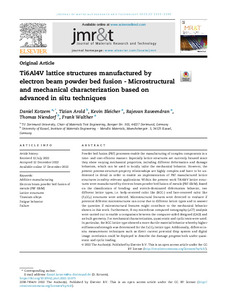| dc.date.accessioned | 2023-05-03T14:02:16Z | |
| dc.date.available | 2023-05-03T14:02:16Z | |
| dc.date.issued | 2022-12-17 | |
| dc.identifier | doi:10.17170/kobra-202304207853 | |
| dc.identifier.uri | http://hdl.handle.net/123456789/14648 | |
| dc.language.iso | eng | eng |
| dc.rights | Namensnennung 4.0 International | * |
| dc.rights.uri | http://creativecommons.org/licenses/by/4.0/ | * |
| dc.subject | additive manufacturing | eng |
| dc.subject | electron beam powder bed fusion of metals (PBF-EB/M) | eng |
| dc.subject | lattice structures | eng |
| dc.subject | titanium alloys | eng |
| dc.subject | fatigue behavior | eng |
| dc.subject | failure | eng |
| dc.subject.ddc | 620 | |
| dc.subject.ddc | 660 | |
| dc.title | Ti6Al4V lattice structures manufactured by electron beam powder bed fusion - Microstructural and mechanical characterization based on advanced in situ techniques | eng |
| dc.type | Aufsatz | |
| dcterms.abstract | Powder bed fusion (PBF) processes enable the manufacturing of complex components in a time- and cost-efficient manner. Especially lattice structures are currently focused since they show varying mechanical properties, including different deformation and damage behaviors, which can be used to locally tailor the mechanical behavior. However, the present process-structure-property relationships are highly complex and have to be understood in detail in order to enable an implementation of PBF manufactured lattice structures in safety-relevant applications. Within the present work Ti6Al4V lattice structures were manufactured by electron beam powder bed fusion of metals (PBF-EB/M). Based on the classification of bending- and stretch-dominated deformation behavior, two different lattice types, i.e. body-centered cubic like (BCC-) and face-centered cubic like (F2CCZ) structures were selected. Microstructural features were detected to evaluate if potential different microstructures can occur due to different lattice types and to answer the question if microstructural features might contribute to the mechanical behavior shown in this work. Furthermore, X-ray microfocus computed tomography (μCT) analysis were carried out to enable a comparison between the computer-aided designed (CAD) and as-built geometry. For mechanical characterization, quasi-static and cyclic tests were used. In particular, the BCC lattice type showed a more ductile material behavior whereby higher stiffness and strength was determined for the F2CCZ lattice type. Additionally, different in-situ measurement techniques such as direct current potential drop system and digital image correlation could be deployed to describe the damage progress both under quasi-static and cyclic loading. | eng |
| dcterms.accessRights | open access | |
| dcterms.creator | Kotzem, Daniel | |
| dcterms.creator | Arold, Tizian | |
| dcterms.creator | Bleicher, Kevin | |
| dcterms.creator | Raveendran, Rajevan | |
| dcterms.creator | Niendorf, Thomas | |
| dcterms.creator | Walther, Frank | |
| dc.relation.doi | doi:10.1016/j.jmrt.2022.12.075 | |
| dc.subject.swd | Rapid Prototyping <Fertigung> | ger |
| dc.subject.swd | Selektives Laserschmelzen | ger |
| dc.subject.swd | Gitter | ger |
| dc.subject.swd | Mikrostruktur | ger |
| dc.subject.swd | Titanlegierung | ger |
| dc.subject.swd | TiAl6V4 | ger |
| dc.subject.swd | Materialermüdung | ger |
| dc.type.version | publishedVersion | |
| dcterms.source.identifier | eissn:2214-0697 | |
| dcterms.source.journal | Journal of Materials Research and Technology | eng |
| dcterms.source.pageinfo | 2111-2130 | |
| dcterms.source.volume | Volume 22 | |
| kup.iskup | false | |


